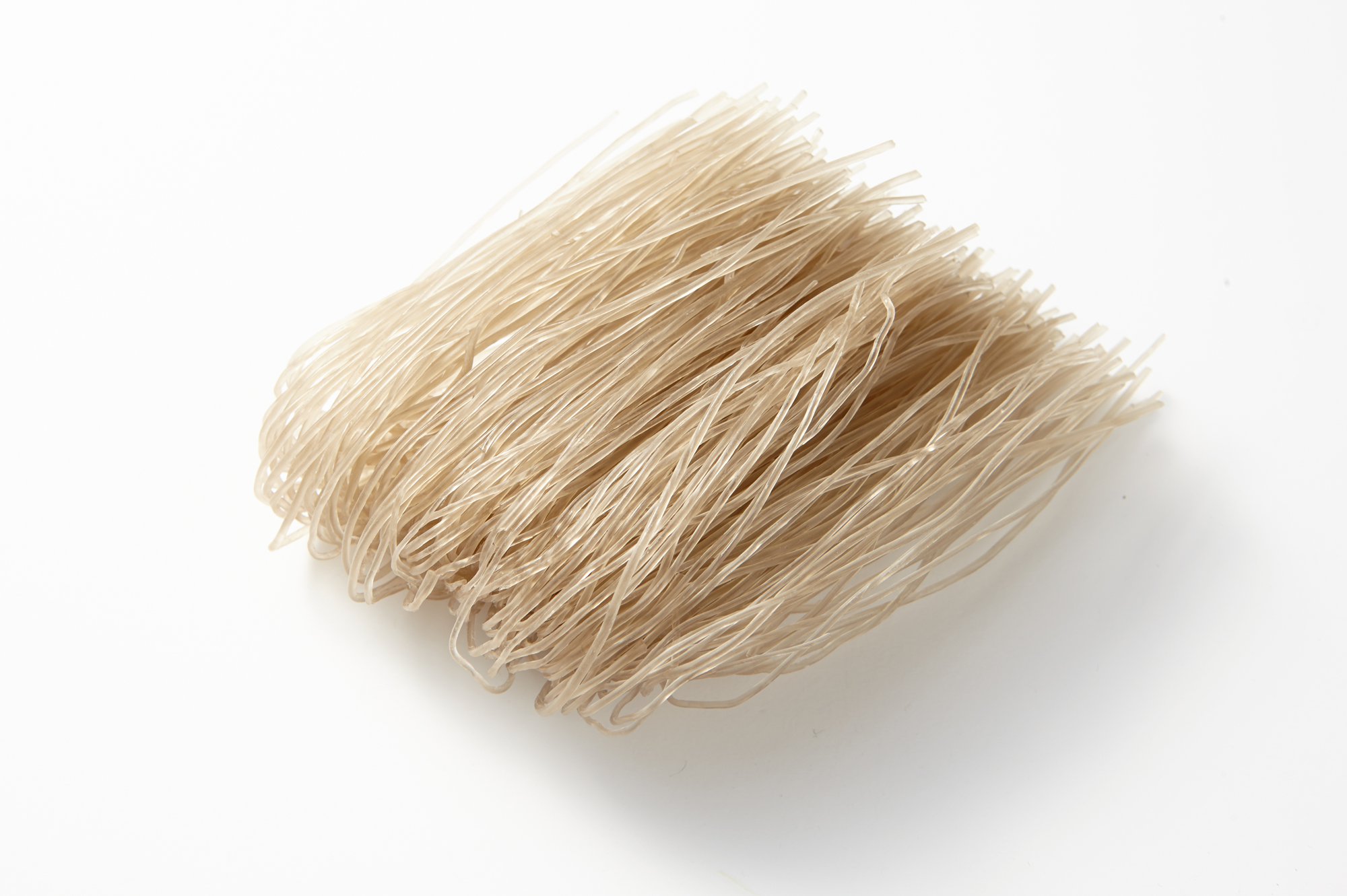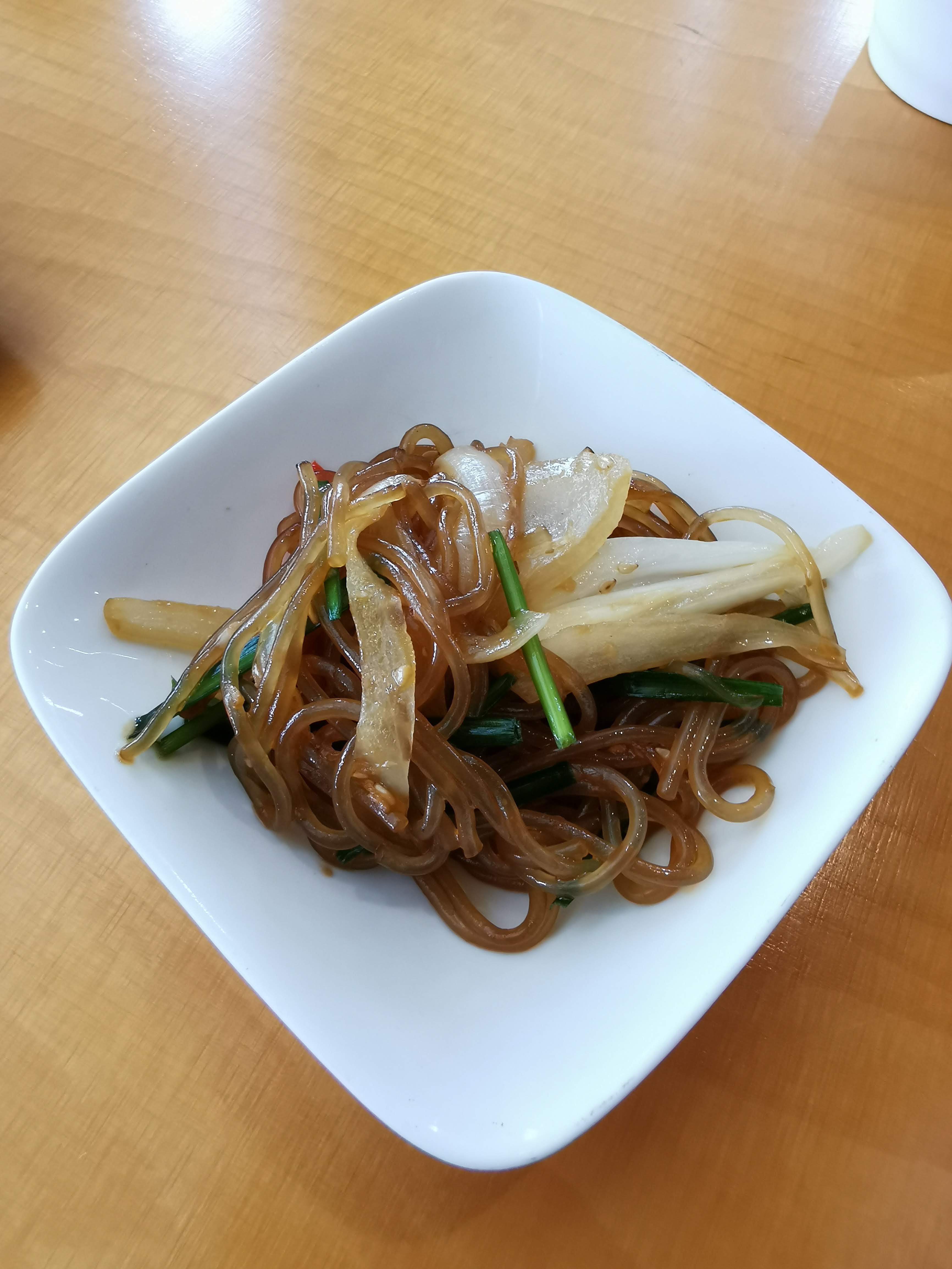Japchae on:
[Wikipedia]
[Google]
[Amazon]
''Japchae'' () is a savory and slightly sweet dish of stir-fried
 '' Dangmyeon'' are pale grey, semi-transparent, chewy and elastic noodles made from sweet potato starch. They are also known as "glass noodles", "cellophane noodles", or "sweet potato vermicelli". The noodles may be soaked in water before cooking. Noodles are sometimes soaked in hot water and then stir-fried. The assortment of vegetables in ''japchae'' may vary, with typical ingredients including
'' Dangmyeon'' are pale grey, semi-transparent, chewy and elastic noodles made from sweet potato starch. They are also known as "glass noodles", "cellophane noodles", or "sweet potato vermicelli". The noodles may be soaked in water before cooking. Noodles are sometimes soaked in hot water and then stir-fried. The assortment of vegetables in ''japchae'' may vary, with typical ingredients including

glass noodles
Cellophane noodles, or fensi (), sometimes called glass noodles, are a type of transparent noodle made from starch (such as mung bean starch, potato starch, sweet potato starch, tapioca, or canna starch) and water. A stabilizer such as chitosan ...
and vegetables that is popular in Korean cuisine.
* ''Japchae'' is typically prepared with '' dangmyeon'' (당면, 唐麵), a type of cellophane noodles made from sweet potato starch; the noodles are mixed with assorted vegetables, meat, and mushrooms, and seasoned with soy sauce and sesame oil
Sesame oil is an edible vegetable oil derived from sesame seeds. The oil is one of the earliest-known crop-based oils. Worldwide mass modern production is limited due to the inefficient manual harvesting process required to extract the oil. ...
.
Once a royal dish, japchae is now one of the most popular traditional celebration dishes, often served on special occasions, such as weddings, birthdays (especially '' dol'', the first birthday, and '' hwangap'', the sixtieth), and holidays. It is also popular at banquets, parties, and potlucks, due to the ease of bulk preparation and flexible serving: ''japchae'' can be served warm, at room temperature, or cold from the refrigerator, and can be eaten freshly made or the day after.
''Japchae'' is commonly served as a ''banchan
''Banchan'' (, from Korean: ) or bansang are small side dishes served along with cooked rice in Korean cuisine. As the Korean language does not distinguish between singular and plural grammatically, the word is used for both one such dish o ...
'' (side dish), though it may also be eaten as a main dish. It is sometimes served on a bed of rice: with rice, it is known as ''japchae-bap'' ().
Etymology and history
The Sino-Korean word ''japchae'' (; ) consists of two syllables, ''jap'' (; ) meaning "mixed" and ''chae'' (; ) meaning "vegetable". According to ''Veritable Records of the Joseon Dynasty
The ''Veritable Records of the Joseon Dynasty'' (also known as the ''Annals of the Joseon Dynasty'' or the ''True Record of the Joseon Dynasty''; ko, 조선왕조실록 and ) are the annual records of Joseon, the last royal house to rule K ...
'', the name originally referred to a stir-fried vegetable
Vegetables are parts of plants that are consumed by humans or other animals as food. The original meaning is still commonly used and is applied to plants collectively to refer to all edible plant matter, including the flowers, fruits, stems, ...
and mushroom
A mushroom or toadstool is the fleshy, spore-bearing fruiting body of a fungus, typically produced above ground, on soil, or on its food source. ''Toadstool'' generally denotes one poisonous to humans.
The standard for the name "mushroom" is ...
dish, first made in the early 17th century by Yi Chung (1568‒1619) for King Gwanghaegun's palace banquet, related to the Fujianese dish of cha̍p-chhài (雜菜), of which the Indonesian Cap Cai is a variant. The king liked the dish so much that he rewarded Yi by promoting him to a high-ranking position, equivalent to the position of Secretary of the Treasury
The United States secretary of the treasury is the head of the United States Department of the Treasury, and is the chief financial officer of the federal government of the United States. The secretary of the treasury serves as the principal a ...
, and ''japchae'' became a fixture of Korean royal court cuisine. Cooked without noodles or meat at the time, ''japchae'' was considered a luxurious and elegant dish served to the royal family and high-level officials. Cucumbers, radishes, and shiitake mushroom
The shiitake (alternate form shitake) (; ''Lentinula edodes'') is an edible mushroom native to East Asia, which is now cultivated and consumed around the globe. It is considered a medicinal mushroom in some forms of traditional medicine.
Ta ...
s were among the vegetables used in this period.
''Japchae'', like other royal dishes, was eventually adopted into the cuisine of common people. Its popularity increased later in the 20th century when cellophane noodles made from sweet potato starch were introduced to Korea from China. The noodles have since become an integral and primary ingredient of ''japchae''. Beef and other meats have been added to the noodle dish, while experimentation and adaptations have led to many noodle-less variations made with seafood, herbs, peppers
Pepper or peppers may refer to:
Food and spice
* Piperaceae or the pepper family, a large family of flowering plant
** Black pepper
* ''Capsicum'' or pepper, a genus of flowering plants in the nightshade family Solanaceae
** Bell pepper
** Chili ...
, bean sprouts
Sprouting is the natural process by which seeds or spores germinate and put out shoots, and already established plants produce new leaves or buds, or other structures experience further growth.
In the field of nutrition, the term signifies ...
, and other ingredients.
Ingredients and preparation
 '' Dangmyeon'' are pale grey, semi-transparent, chewy and elastic noodles made from sweet potato starch. They are also known as "glass noodles", "cellophane noodles", or "sweet potato vermicelli". The noodles may be soaked in water before cooking. Noodles are sometimes soaked in hot water and then stir-fried. The assortment of vegetables in ''japchae'' may vary, with typical ingredients including
'' Dangmyeon'' are pale grey, semi-transparent, chewy and elastic noodles made from sweet potato starch. They are also known as "glass noodles", "cellophane noodles", or "sweet potato vermicelli". The noodles may be soaked in water before cooking. Noodles are sometimes soaked in hot water and then stir-fried. The assortment of vegetables in ''japchae'' may vary, with typical ingredients including mushroom
A mushroom or toadstool is the fleshy, spore-bearing fruiting body of a fungus, typically produced above ground, on soil, or on its food source. ''Toadstool'' generally denotes one poisonous to humans.
The standard for the name "mushroom" is ...
s, carrots, spinach, onion
An onion (''Allium cepa'' L., from Latin ''cepa'' meaning "onion"), also known as the bulb onion or common onion, is a vegetable that is the most widely cultivated species of the genus ''Allium''. The shallot is a botanical variety of the onio ...
s, egg and scallions
Scallions (also known as spring onions or green onions) are vegetables derived from various species in the genus ''Allium''. Scallions generally have a milder taste than most onions and their close relatives include garlic, shallot, leek, chi ...
. Commonly used mushrooms are wood ear, shiitake
The shiitake (alternate form shitake) (; ''Lentinula edodes'') is an edible mushroom native to East Asia, which is now cultivated and consumed around the globe. It is considered a Medicinal fungi, medicinal mushroom in some forms of tradition ...
, and oyster mushrooms
''Pleurotus'' is a genus of gilled mushrooms which includes one of the most widely eaten mushrooms, '' P. ostreatus''. Species of ''Pleurotus'' may be called oyster, abalone, or tree mushrooms, and are some of the most commonly cultivated edib ...
. Both beef and pork are commonly used for ''japchae''. Each ingredient is stir-fried separately before being mixed with boiled and drained noodles, and seasoned with soy sauce, sugar, chopped garlic and sesame oil. The dish is usually garnished with toasted sesame seeds
Sesame ( or ; ''Sesamum indicum'') is a flowering plant in the genus '' Sesamum'', also called benne. Numerous wild relatives occur in Africa and a smaller number in India. It is widely naturalized in tropical regions around the world and is cu ...
and chili threads, and served hot or cold.
Varieties

Royal court dishes
* ''Gyeoja-chae'' () * ''Jokchae'' () – made with shredded ''jokpyeon
''Jokpyeon'' () is a dish in Korean cuisine prepared by boiling cow's trotters and other cuts with high collagen content, such as cow's head, skin, tail and pig's head in water for a long time, so that the stewing liquid sets to form a jelly-lik ...
'' (trotter jelly) and vegetables
* ''Tangpyeong-chae
''Tangpyeong-chae''
* (, 蕩平菜) or mung bean jelly salad is a Korean dish that was part of the Korean royal court cuisine. It is made by mixing julienned ''nokdumuk'', mung bean sprouts, watercress, stir-fried shredded beef, thinly shredde ...
'' () – made with '' nokdu-muk'' (mung bean jelly), beef, mung bean sprouts, water dropwort
Water dropwort is a common name for several genera of plants and may refer to:
* ''Oenanthe'' (plant)
* ''Oxypolis
''Oxypolis'' is a small genus of North American flowering plants in the carrot family known as cowbane, water dropwort, dropwort ...
, and mugwort
Mugwort is a common name for several species of aromatic flowering plants in the genus '' Artemisia.'' In Europe, mugwort most often refers to the species ''Artemisia vulgaris'', or common mugwort. In East Asia the species ''Artemisia argyi'' is ...
* '' Wolgwa-chae'' () – made with Oriental pickling melon, beef, and vegetables
* ''Juksoon-chae'' () - made with bamboo shoot
Bamboo shoots or bamboo sprouts are the edible shoots (new bamboo culms that come out of the ground) of many bamboo species including ''Bambusa vulgaris'' and ''Phyllostachys edulis''. They are used as vegetables in numerous Asian dishes and ...
s and vegetables
Other dishes
* '' Gochu-japchae'' () – made with shredded green pepper and vegetables * ''Buchu-japchae'' () – made with garlic chives * ''Kongnamul-japchae'' () – made with soybean sprouts * ''Haemul-japchae'' () – made with seafood and vegetables * ''Beoseot-japchae'' () – made with mushrooms * ''Gungjung-japchae'' () - made with high-grade ingredients and royal vegetablesSee also
* '' Gochu-japchae'' * ''Tangpyeong-chae
''Tangpyeong-chae''
* (, 蕩平菜) or mung bean jelly salad is a Korean dish that was part of the Korean royal court cuisine. It is made by mixing julienned ''nokdumuk'', mung bean sprouts, watercress, stir-fried shredded beef, thinly shredde ...
''
* '' Wolgwa-chae''
* List of sweet potato dishes
References
{{Noodle Korean noodle dishes Mixed noodles